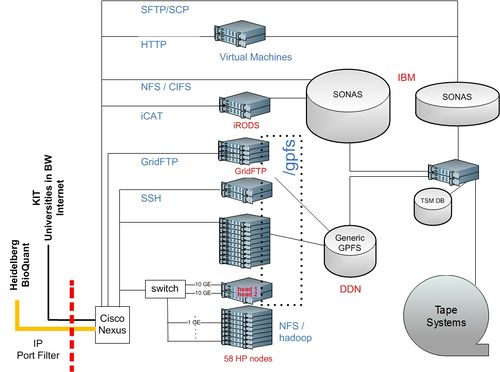Data services: Difference between revisions
From Lsdf
Jump to navigationJump to search
No edit summary |
mNo edit summary |
||
| (23 intermediate revisions by 6 users not shown) | |||
| Line 1: | Line 1: | ||
[[File:hw_lsdf.jpg|500px|right]] |
|||
The services currently provided by LSDF are: |
|||
* Fast reliable storage acessible via standard protocols |
|||
* [[Archival services]] for long term access to data |
|||
* Cloud storage: [[S3 / REST]] |
|||
| ⚫ | |||
* GridFTP [[Data Transfers]] |
|||
* HTTP/SFTP [[data sharing service]] |
|||
* [[GPU nodes (NVIDIA)]] |
|||
== Access and use of services and resources == |
|||
* Storage |
|||
* Request [[Access to Resources]] |
|||
* Cloud computing |
|||
* After access is granted, continue to [[registration]] |
|||
| ⚫ | |||
* About [[LSDF Usage]] |
|||
* Acceptible [[Services Usage]] |
|||
The Hadoop cluster consists of 58 nodes with 464 physical cores, 36 GB of RAM and 2 TB of disk each. All nodes are however SHARED between the different Hadoop tasks and the OpenNebula virtual machines. |
|||
Latest revision as of 10:27, 29 July 2016
- Fast reliable storage acessible via standard protocols
- Archival services for long term access to data
- Cloud storage: S3 / REST
- Hadoop data intensive computing framework
- GridFTP Data Transfers
- HTTP/SFTP data sharing service
- GPU nodes (NVIDIA)
Access and use of services and resources
- Request Access to Resources
- After access is granted, continue to registration
- About LSDF Usage
- Acceptible Services Usage
